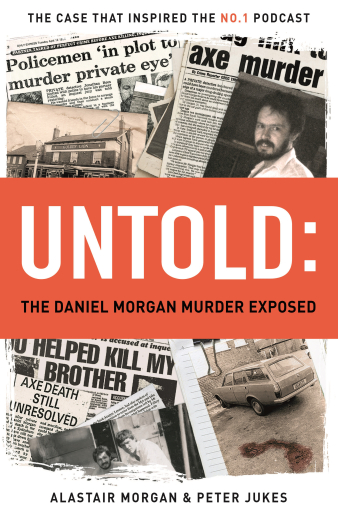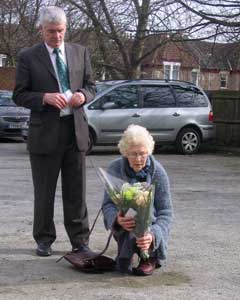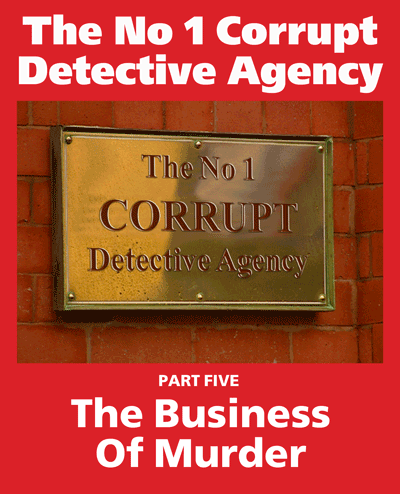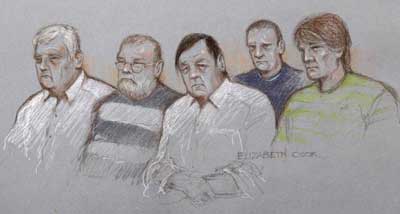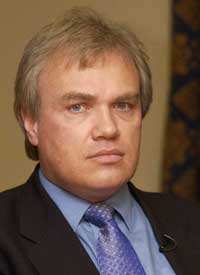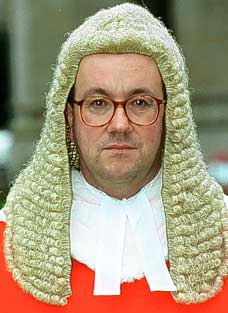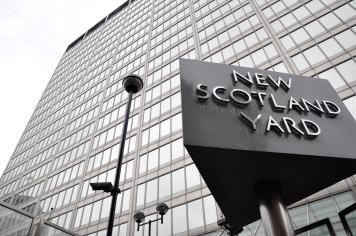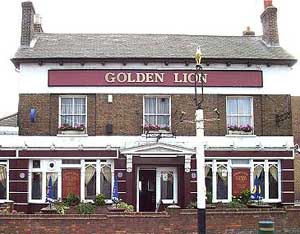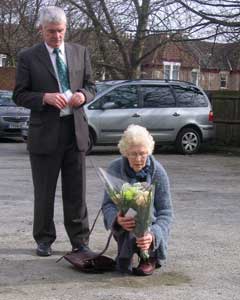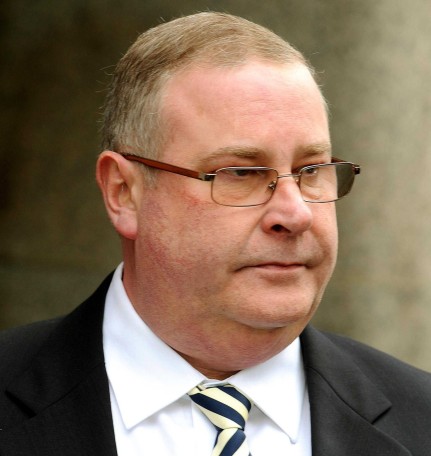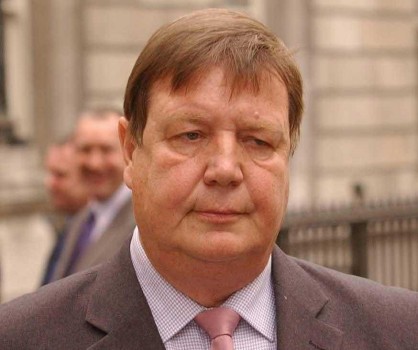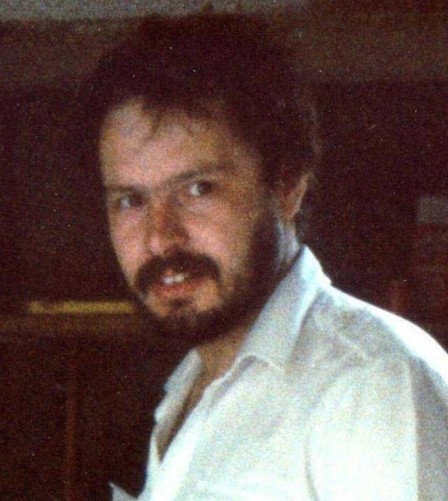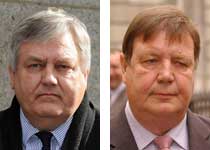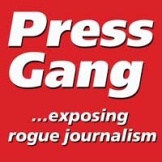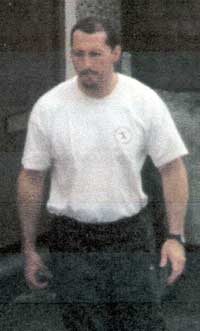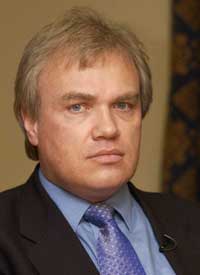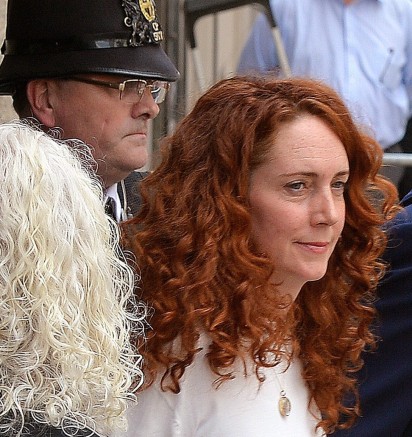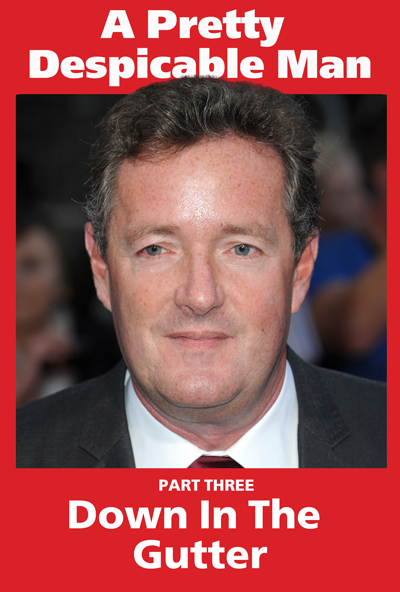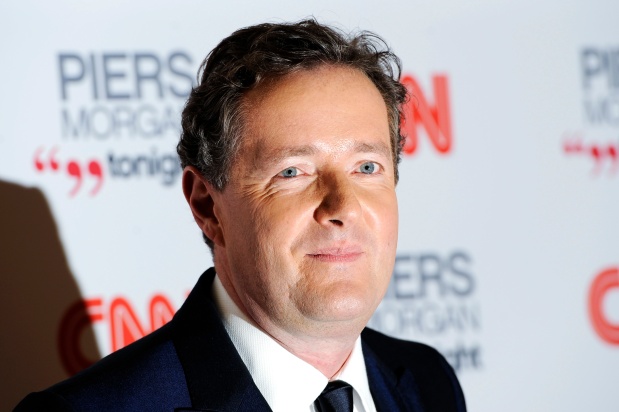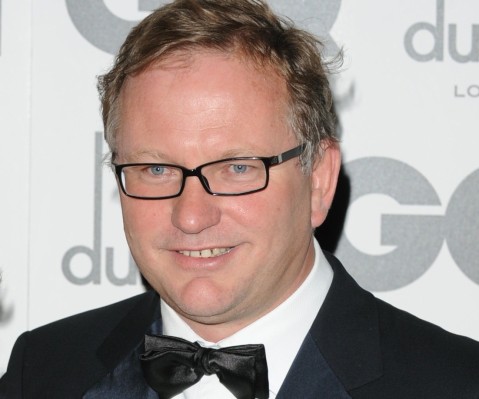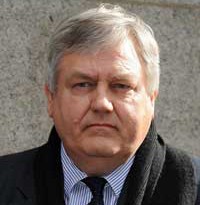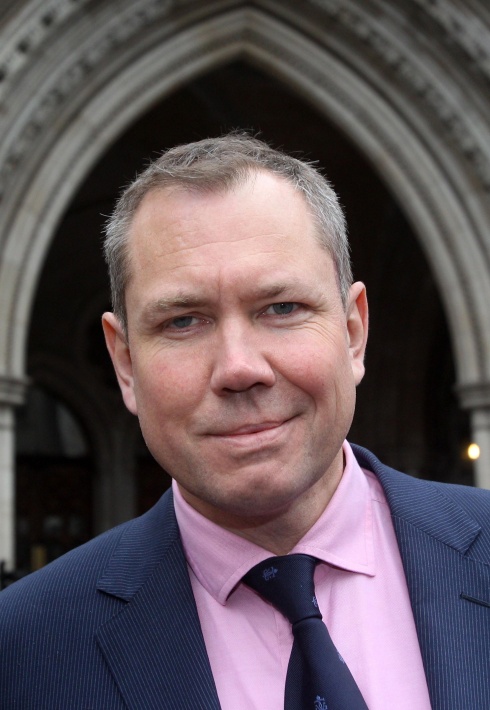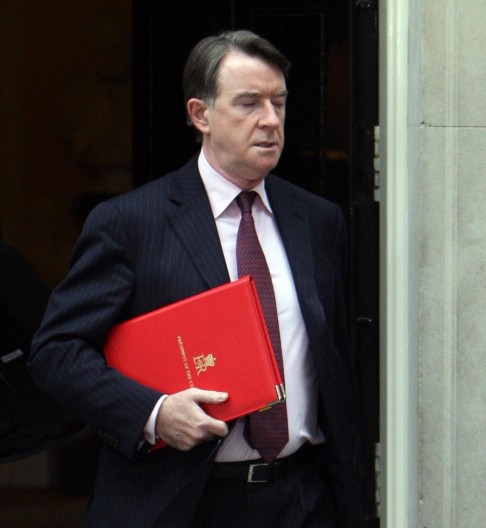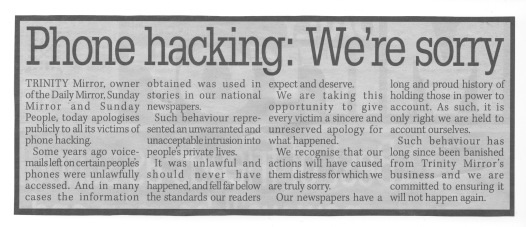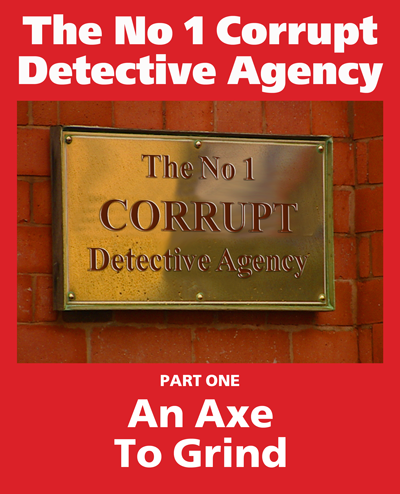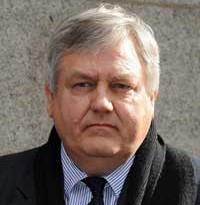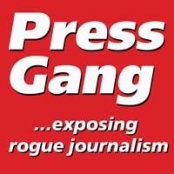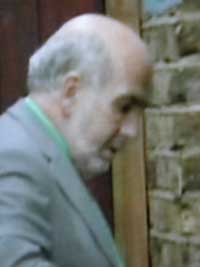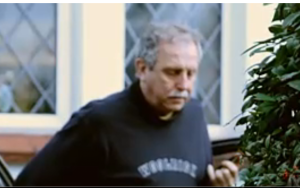
THE PRIME suspect in the unsolved Daniel Morgan murder has always enjoyed the support of powerful newspapers.
Five police investigations identified Jonathan Rees — boss of Southern Investigations, the No 1 Corrupt Detective Agency — as the only credible suspect in the brutal 1987 murder.
Also suspected of involvement in the killing was Rees’ close friend Sidney Fillery, a Scotland Yard detective who served on the initial murder investigation.
Despite their notoriety, Rees and Fillery enjoyed the confidence of the News of the World for a quarter of a century.
Even after Rees was gaoled for seven years for conspiring to ruin an innocent woman, the paper’s editor Andy Coulson stood by his man.
In 2008 Rees and Fillery were charged in connection with Daniel Morgan’s murder.
The prosecution — dogged by unreliable witnesses and documents not disclosed to the defence — finally collapsed in 2011.
Jonathan Rees has persuaded the Mail on Sunday to publish articles portraying him as an innocent man.
In August 2014 chief reporter Ian Gallagher and freelance journalist Sylvia Jones published a highly sanitized version of the case.
Press Gang complained to Mail editor-in-chief Paul Dacre — and no further articles have appeared.
Now Private Eye has published a series of articles — in its “In The Back” section — highly favourable to the pair.

THE STORY SO FAR …
FOR THREE decades police believed private detective Jonathan Rees (left) was the prime mover in the murder.
They believe he recruited brother-in-law Glenn Vian to carry out the 1987 killing. Glenn’s brother, Garry, was the look-out man.
Detectives say Rees relied on close friend Sidney Fillery (right), a Scotland Yard detective, to frustrate the investigation.
Fillery was on the murder team for several days before his relationship with Rees emerged.
Fillery retired from the police shortly after the murder — and stepped into the dead man’s shoes at Southern Investigations.
For the events leading up to the murder, the early contaminated murder inquiry, the sensational inquest which saw Ree’s book-keeper accuse him of planning the murder, see Part One — An Axe To Grind.
The second — Rogue Journalists & Bent Coppers — reveals how Rees and his new partner Fillery became key players in the unlawful sale of confidential police information to national newspapers, especially the News of the World. Attempts by anti-corruption detectives to end this corrosive trade came to nothing.
The third police investigation failed to bring the killers of Daniel Morgan to book — but Rees was gaoled for seven years after he was caught conspiring with corrupt Scotland Yard detectives to plant drugs on a young mother. A search of Fillery’s computer found images of extreme child sex abuse — he was convicted and ordered to sign the Sex Offenders’ Register. The story is told in Porridge, the third instalment of The No 1 Corrupt Detective Agency.
In 2008 Rees and Fillery were finally charged in connection with Daniel Morgan’s murder but the case collapsed after key witnesses were found to be unreliable and boxes of evidence were not disclosed to the defence. An account of the trial can be found in the fourth instalment Getting Away With Murder.
Rees and Fillery then went on the attack — suing Scotland Yard for malicious prosecution and misfeasance in public office. Only Fillery was partly successful. The Press Gang article, The Business Of Murder, the fifth part of the series, is the longest published account of their civil action.
Photos: PA
Press Gang made several attempts to persuade editor Ian Hislop’s journalists to produce more balanced reports.
All were ignored.
It wasn’t until this article was about to go to press — and more than three months after we first contacted them — that Private Eye finally addressed our concerns.
Editor Ian Hislop sent us a three page letter and insisted we print it all …
♦♦♦
THE FOUR Private Eye articles were published in December last year and January, February and March of this year.
They were reports of the High Court action brought by Rees, Fillery and Glenn and Garry Vian against the Metropolitan Police.
The four men were claiming the criminal case which collapsed in 2011 was a “malicious prosecution” by Scotland Yard.
As a result, Rees and his former brother-in-law Glenn Vian spent 22 months in prison on remand.
Glenn Vian’s brother, Garry, was already serving a 14 year sentence for drug smuggling.
Fillery was detained for three months.
The four also claimed the senior investigating officer in the case, detective chief superintendent Dave Cook, was guilty of “misfeasance in public office.”
The criminal case against them collapsed partly because a key prosecution witness was found to be unreliable.
The judge in the case, which was abandoned in 2011, decided ex-DCS Cook had probably coached the witness to change his testimony.
The civil action was heard before Mr Justice Mitting at the High Court.
The four Private Eye articles appeared in the magazine’s “In The Back” section, supervised by reporter Heather Mills.
The first — “Judge dread” — appeared in December last year.
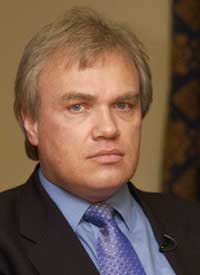
EX-DCS DAVE COOK
THE EXPERIENCED murder detective was the senior investigating officer in the fourth and fifth attempts to bring Daniel Morgan’s murderers to book. Cook came in for serious criticism — accused of attempting to pervert the course of justice — during the pre-trial hearings in the criminal case which collapsed in 2011. For Private Eye he is a nothing more than a corrupt detective who should be in the dock. For many seasoned watchers of the saga, including Press Gang, no other police officer has done more to solve the case. He has paid a high price for his dedication — a painful divorce and the lasting enmity of the Metropolitan Police …
Photo: PA
It reported that Judge Mitting was losing patience that ex-DCS Dave Cook had not given a statement in the case.
The judge gave counsel for the Metropolitan Police, the defendants in the action, ten days to provide a statement from ex-DCS Cook.
“I am thinking of putting a gun to your head with a bullet that will fire in a short period of time,” he said.
Cook had already produced a note from a doctor claiming he was depressed and that giving evidence would further damage his mental health.
Private Eye stated:
“The Met maintained that it would fight on even if no statement from Cook materialised by 9 December deadline.”
“But without him, it may have to settle the claim, which has already exceeded £1.5m in legal costs.”
This was followed by a second piece in January this year.
“Back in court” was even more critical of ex-DCS Cook:
“How ironic that the best chance of finding out why the murder of south London private investigator Daniel Morgan … remains unsolved after 30 years now lies with a claim of malicious prosecution and malfeasance in public office being brought against the Metropolitan police by the key suspects.’
It summarised Rees and Fillery’s case by quoting their QC, Nicholas Bowen:
“Between 2005 and 2006, he [ex-DCS Cook] coached and manipulated the two main witnesses, failed to investigate exculpatory lines of inquiry, suppressed documents, misled his colleagues and lied to the trial judge.”
The piece noted that the Metropolitan police would continue without Cook — there were “multiple accounts from various of the claimants’ associates” of the plaintiffs’ involvement in the murder.
“Cook feels the heat” — the third article, published in February — reported Mr Justice Mitting’s verdict, dismissing the claim for “malicious prosecution” in its entirety.
Mitting ruled that only Fillery had suffered as a result of DCS Cook’s misfeasance in public office — he will receive substantial damages.
The Eye was clearly not expecting this verdict — and called it “controversial.”
It said there would be an appeal.

PRIME SUSPECTS
AN ARTIST’S impression of the five men charged in connection with the Daniel Morgan murder in 2008 — from left to right, Jonathan Rees, Glenn Vian, Sid Fillery, Garry Vian and James “Jimmy” Cook. After the case collapsed all but Cook sued the Metropolitan Police for malicious prosecution and misfeasance in public office.
Illustration: Elizabeth Cook, PA
The magazine added:
“After the hearing, Daniel’s brother Alistair Morgan said it would be a ‘travesty of justice’ if Cook were to become the scapegoat for the ‘decades’ of police corruption at the centre of the unsolved murder.”
“And he is right — as Eye readers will be well aware, the case was fouled long before Cook.”
“But people are innocent until proven guilty no matter their criminal record or what the police believe.”
The final piece — “Cook’s stew” — appeared in March.
The Eye made it clear that DCS Cook should be prosecuted for perverting the course of justice:
” … the evidence and public interest test clearly having been met, with two trials and two adverse findings by two high court judges about Cook’s conduct.”
The magazine was irritated by parts of the High Court judgment.
“With judicial clairvoyance, Mitting decided that Cook only perverted the course of justice – by illicitly prompting a mentally unstable, renowned liar – because he ‘genuinely’ believed the four were guilty.”
The piece also noted “supporters of Cook say he is a fall guy for the Yard’s internal politics and its close relationship with the News of the World, which Rees and Fillery worked for as private contractors.”
But the Eye still believes Cook should be prosecuted:
“As the 30th anniversary of Morgan’s murder passes on 10 March, surely the most ‘appropriate’ action for new Met Commissioner Cressida Dick must be to support a fair prosecution of Cook.”
♦♦♦
THE PRIVATE EYE coverage was a propaganda coup for Rees and Fillery.
But it was only achieved by leaving out relevant information which readers needed to make an informed judgement.
The magazine
— failed to declare that the freelance journalist largely responsible for the coverage, Michael Gillard, has a personal axe to grind in this case
— failed to explain the history of ex-DCS Cook’s involvement in the case and how Fillery persuaded the News of the World to cynically — and criminally — target him and his wife
— failed to give a balanced view of Cook’s role in the case
— failed to tell its readers about the criminal past of Rees, in particular his breathtaking attempt to ruin an innocent woman by using corrupt police officers to plant drugs in her car
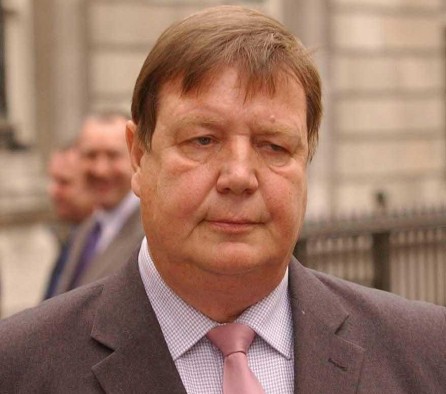
EX-DETECTIVE SERGEANT SIDNEY FILLERY
FOR SEVERAL days in 1987 Fillery was a key officer in the initial Morgan murder investigation. He claimed he left the investigation when it became clear that there was a conflict of interest. The senior investigating officer, however, said that he ordered him off the inquiry when he discovered he was a close friend of Rees. Fillery was arrested shortly afterwards but released without charge. In 2002 he was convicted of fifteen counts of making indecent images of children.
Photo: PA
— failed to tell readers that, during the fourth investigation into the murder, a search of Fillery’s computer revealed a cache of extreme images of child sexual abuse
— failed to tell readers that in 2011 Scotland Yard apologised to the Morgan family for the fact that Fillery’s corruption made a successful prosecution almost impossible.
— failed to tell readers that Alastair Morgan, the brother of the murdered detective, has believed almost from day one that Rees ordered the killing — and that Fillery covered up for him.
♦♦♦
THE DRIVING force behind the Eye articles is the widely respected journalist Michael Sean Gillard.
The son of Michael Gillard, who writes the magazine’s ‘Slicker’ column, he was voted Journalist of the Year in 2013 by the British Journalism Society.
The Society awarded him the prize for his long inquiry into the activities of East End crime boss David Hunt.
He remains in fear of retribution from underworld figures and maintains a low profile.
This Press Gang article does not include his photograph for that reason.
Gillard has also investigated police corruption for more than two decades.
In 2000 he clashed with Scotland Yard over his reporting.
At the time he was working for the Guardian along with another freelance journalist Laurie Flynn.
They were investigating the record of the Metropolitan Police anti-corruption team — the so-called Untouchables.
In 2000 Commander Andy Hayman, then in charge of the Untouchables, became concerned about the activities of Gillard and Flynn.
The third investigation into the Daniel Morgan murder was under way.
Police had bugged the offices of Southern Investigations and heard Jonathan Rees planning a criminal conspiracy with one of his clients.
The client, Simon James, was locked in a custody battle with his wife Kim over their son Daniel.
James went to Rees who cooked up a plan to plant cocaine in her car — and then arrange for a corrupt detective inform on her.
In 2000 Rees, James and the bent copper were arrested.
(All were later gaoled: Rees and James for seven years, the corrupt Scotland Yard detective for five).
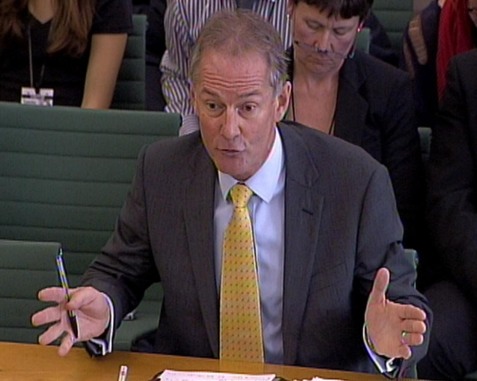
ANDY HAYMAN
IN 2000 the Scotland Yard Commander became concerned that Jonathan Rees might use Michael Gillard to undermine the prosecution case against him.
Photo: PA
Commander Hayman was worried Rees would use his relationship with Gillard and Flynn to plant stories that might compromise the prosecution.
In August 2000 Hayman wrote to then Guardian editor Alan Rusbridger.
“I have concerns,” he wrote, “that in their research your journalists may be at risk, perhaps unwittingly, of assisting Rees in unethically or unlawfully seeking his acquittal in the serious charges he will be required to answer to trial at the Central Criminal Court.”
The Untouchables had already expressed concern about Rees and Fillery.
A 1998 report stated:
“They are alert, cunning and devious individuals who have current knowledge of investigative methods and techniques which may be used against them …”
“Such is their level of access to individuals within the police, through professional and social contacts, that the threat of compromise to any conventional investigation against them is constant and very real.”
Gillard and Flynn insist they had no intention of writing about the Kim James case.
They believe Hayman’s letter led to the paper stopping their investigation into the Untouchables.
Gillard and Flynn withdrew from the paper and, in 2004, published their book Untouchables.
Untouchables is an important book and includes a rigorously fair account of the Daniel Morgan case.
The book’s thesis is that Scotland Yard’s anti-corruption campaign
” … is a phoney war, which by fostering the illusion of ruthless efficiency and success seeks to ensure that Scotland Yard continues to police itself and protect its darkest recesses from public scrutiny.”
Gillard and Flynn then add
“Since we began this journey into the dark side of the Yard, senior officers have done their best to prevent this investigation reaching you.”
“We have been threatened, assaulted, lied to, smeared by the organisation”.
“We also uncovered a plot by the Yard to derail our inquiries by making false allegations of criminal conduct in a letter to … Alan Rusbridger, which was kept from us.”
The Guardian rejected this criticism.
Alan Rusbridger told the trade magazine Press Gazette in 2001:
“The Guardian invested a large amount of time, money and the best legal resources we could find to back Laurie and Michael in their investigation into alleged police corruption.”

ALAN RUSBRIDGER
THE GUARDIAN editor denied Michael Gillard’s claim that Scotland Yard had forced the newspaper to drop his investigation into police corruption.
Photo: PA
“Our unequivocal and unanimous legal advice at the end of the day was that we could not defend the allegations that they were seeking to make.”
Rusbridger says he never saw Hayman’s letter.
After finally reading it, he noted:
“It contained no serious allegations about Michael and Laurie and was in no sense an attempt to place the Guardian under any pressure.”
♦♦♦
IN HIS four Private Eye articles Gillard is silent about the background to ex-DCS Cook’s involvement in the Daniel Morgan murder.
An experienced murder squad detective, Cook was approached in 2002 to appear on the BBC Crimewatch programme.
He was married to policewoman Jacqui Hames, who was also a presenter on the programme.
He was asked to pretend he was the senior investigating officer in the third investigation into the Daniel Morgan murder.
In fact, the investigation was being handled by Scotland Yard’s anti-corruption team — although Cook later took the job for real.
In June 2002 Cook appeared on the programme to appeal for witnesses to the murder.
The next day, Cook was told by anti-corruption officers that Sid Fillery had been in touch with reporter Alex Marunchak at the News of the World the night before the broadcast.
(At the time, Rees was still in prison for the Kim James conspiracy.)
Fillery and Marunchak were overheard to agree that they would “sort out” the detective.
What followed was a full-scale “dark arts” operation against Cook and his wife.
A few days after the broadcast Cook was told by Surrey Police, where he worked from 1996 to 2001, that someone had rung asking for his address.
The caller said they were working for the Inland Revenue and wanted it to send Cook a tax refund.
It later became clear that Glen Mulcaire — the private eye gaoled in 2007 with News of the World royal correspondent Clive Goodman for hacking into royal mobiles — obtained Cook’s address, his internal Met payroll number and the amount he and his wife were paying on their mortgage.
Mulcaire also obtained the mobile number for Cook’s wife as well as the password she used.
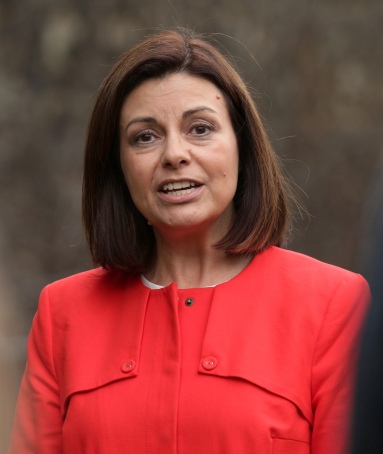
JACQUI HAMES
THE CRIMEWATCH presenter was traumatised when Sid Fillery persuaded the News of the World to target her and her husband, DCS Dave Cook. “The stress that we endured over the subsequent years contributed to the eventual breakdown of my marriage.” She did not learn that her phone was also hacked until 2011 …
Photo: PA
In January 2003 Rebekah Brooks was at Scotland Yard on a social visit when she was asked to have a word with Dave Cook “to clear the air”.
When Cook took her through the events, she insisted Marunchak was a fine reporter.
The Met’s senior brass sided with the News of the World — and sidelined the concerns of Dave Cook and his wife.
The couple found themselves between a rock and a hard place — the News of the World and the indifference of the Met.
The surveillance operation — it came three years after Crimewatch presenter Jill Dando was shot dead outside her London home in 1999 — placed a strain on the couple.
Their marriage didn’t survive and they later divorced.
Michael Gillard says nothing about any of this in the four recent articles.
In our email to Private Eye, we noted:
“Here we have a supposedly blameless ex-Scotland Yard detective, Fillery, presumably anxious to catch the killer of the man into whose shoes ‘somewhat surprisingly’ he stepped, alerting the News of the World … to what exactly?”
“That Cook was having an affair with his own wife?”
“Surely the whole exercise, from Fillery’s point of view, was a cynical attempt to put pressure on the fourth attempt to catch Daniel’s killers?”
In other words, Fillery was attempting to pervert the course of justice — the very charge the Eye levels against ex-DCS Cook.
Even more serious, while the Eye makes it clear the case has been dogged by police corruption it does not say that Fillery is the cause of that corruption
For several days he played a leading role in the investigation — carrying out the first official interview of Jonathan Rees — without telling senior officers he was a close personal friend.
At the end of March 2011, Scotland Yard issued a public apology to the Morgan family.

PUBLIC APOLOGY
ACTING METROPOLITAN POLICE Commissioner Tim Godwin formally apologised in March 2011 to the Morgan family for the force’s failure to convict Daniel’s killers. “You are entitled to an apology not only for this failure but also for the repeated failure [by Scotland Yard] … to accept that corruption had played such a part in failing to bring those responsible to justice.” Private Eye left out the fact that Rees’ friend Fillery was the primary source of that corruption …
Photo: PA
Acting Commissioner Tim Godwin said:
“I recognise how important it is to the family that the part played by corruption in the original investigation is acknowledged publicly.”
The source of that corruption was Sid Fillery who, as a detective sergeant on the first murder investigation, had fatally contaminated the inquiry …
♦♦♦
PRESS GANG tried on several occasions to persuade Private Eye to provide more balanced reporting.
In January, after the first article, we emailed the magazine saying we assumed this piece
” … was written by Mike Gillard and forms part of his assault on the Met for the use of supergrasses.”
“The trouble is, without giving some of the context (such as the fact that Rees was caught red-handed conspiring to plant cocaine on a woman so that she would lose custody of her child), the Eye gives the impression Rees is a wronged-character.”
The Eye ignored this email.
After the second piece, in January, we emailed again.
Again there was no response.
On April 13 we sent a long letter outlining this article.
A week later Heather Mills, the reporter responsible for “In The Back”, replied:
“You have obviously spent a lot of time putting together your letter and its allegations and are apparently intending to make some very serious aspersions.”
“I can see no reason why you should wish to impose an impossible deadline for responding, nor to rush to publish.”
We gave the Eye until last night to respond.
Editor Ian Hislop sent us a three page letter.
(The full letter is printed at the end of this article, in line with our Right of Reply policy.)
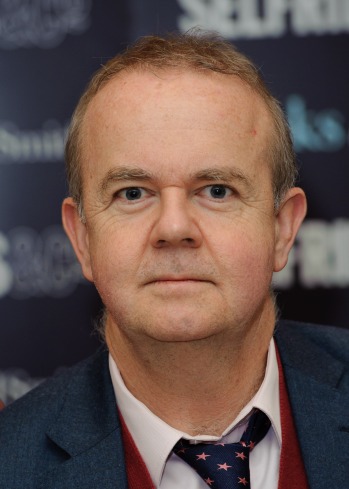
IAN HISLOP
THE EDITOR of Private Eye sent us a three-page letter — insisting Press Gang publish it in full …
Photo: PA
“To be honest,” writes Hislop, “I’m afraid I find it extremely difficult to understand let alone respond to the, frankly, wild allegations you are making against Private Eye … ”
“Contrary to what you suggest these are a fair and accurate account of recent court proceedings and developments.”
He adds
“… you appear to be basing your many and confusing allegations on a suggested ‘lack of context’ in our coverage.”
“In so doing, you are operating on the false basis that we have ignored the aspects of the Morgan case about which you are now complaining.”
He then goes on to spell out what Private Eye has said about the murder in the past, including all the material cited in this article.
But that is not the point Press Gang is making — we say that some of this material should have been included in the four recent articles to present a balanced case.
Moreover, whatever Private Eye has said in the past is no longer available to the vast bulk of the readership.
The magazine provides no publicly available database and index of previous articles.
Hislop hits the nail on the head:
“… you seem intent on suggesting that there is a conspiracy between Michael Gillard and the Eye to embark on an ‘anti-Cook crusade’ that has given ‘succour to the prime suspects in the case.’ This really is nonsense.”
At least in this article, Press Gang presents as much of the material, from both sides, so readers can make up their own mind on the issue.
♦♦♦
REES AND FILLERY are now hoping Channel 4 will give them a platform.
The broadcaster confirmed this morning it had commissioned the independent production company Indefinite Films to work on a series about the murder.
There are concerns that this programme will also present a biased account of the case.
Alastair Morgan has declined to take part.

PETER JUKES
THE PRODUCER of the award-winning podcast series Untold: The Daniel Morgan Murder tried to get Private Eye to publish a letter complaining about its coverage. The Eye refused to publish it …
Photo: PA
Series producer Adam Wishart told us:
“Our aim is provide an authoritative and impartial account of the events leading up to and since Daniel Morgan’s death.”
“The production team will be adhering to the strict Ofcom guidelines around fairness, factual, accuracy and impartiality and their hope is to include interviews with witnesses, people associated with Daniel Morgan and his family.”
However, Press Gang has obtained a copy of an email from producer Jim Nally sent to police officers involved in the case.
Nally says
” … our investigation is very much following the police’s in terms of exposing who had the motive and the connections.”
“We really want to do justice to the Trojan efforts of police to solve this crime …”
But he then goes on to say
“ … we’ve got Sid Fillery on board, which is important, as accusations of police corruption have been so lazily bandied about by the Morgan campaign that we felt it was about time someone said ‘show me the evidence’, which is exactly Sid’s point which he delivered really well.”
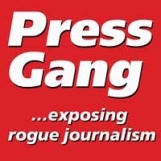
THIS IS the sixth instalment of The No 1 Corrupt Detective Agency, a project that started six years ago and now runs to more than 22,000 words.
It’s one of the three major Press Gang inquiries — the others being the exposé of Mazher “Fake Sheik” Mahmood and the long series on Piers Morgan: “A Pretty Despicable Man”.
Press Gang is independent and carries no advertising. It runs at a loss and the only source of income is donations.
If you feel articles like A Stab In The Back should see the light of day, you can make donation …

This is breathtaking stuff — it ignores the fact that, in 2011, Scotland Yard publicly apologised to the Morgan family for “the part played by corruption in the original investigation.”
The source of that corruption was Sid Fillery.
The retired police officer approached by Nally warned him:
“There was a wealth of evidence that [Fillery] acted inappropriately (to say the least) which was compounded by the fact that he retired and took the victim’s place in the private detective agency.”
“I would seriously warn against any officer contributing to a programme that appears to centre on this ex-officer.”
A spokeswoman for Channel 4 told us:
“Channel 4 has commissioned a multi-award winning production team at Indefinite Films to make an investigative factual series about the events surrounding and following the death of Daniel Morgan.”
“As with everything broadcast on Channel 4, we will retain editorial control and ensure everything is underpinned with robust journalism, presented fairly, accurately and impartially.”
“Daniel Morgan’s family, along with all the key witnesses involved in the story are being approached for this in-depth forensic series.”
♦♦♦
Published: 27 April 2017
© Press Gang
♦♦♦
CORRECTIONS
THIS ARTICLE was amended on 12 & 14 May and 13 June 2017.
Press Gang wrongly stated Michael Gillard “forced the Guardian to make public” the letter to the paper from Scotland Yard Commander Andy Hayman. We apologise for the error.
Michael Gillard also objects to our statement that Rees “persuaded” him and the Eye to publish “favourable” articles. Press Gang stands by its analysis of these articles as “favourable” but Rees didn’t need to persuade Gillard to write them — his critique of ex-DCS Cook dates from 2011. The piece has been amended to reflect this.
RIGHT OF REPLY
Private Eye editor Ian Hislop’s letter
Dear Paddy French,
I promised you a response to your various communications, so here it is at some length after consultation with all those involved.
To be honest, I’m afraid it is extremely difficult to understand let alone respond to the, frankly, wild allegations you are making against Private Eye arising from the latest articles in the magazine concerning the long-running Daniel Morgan case. Contrary to what you suggest these are a fair and accurate account of recent court proceedings and developments.
So we are not going to try and address everything to which you refer; it also follows, just because we have not in this letter addressed a specific point or allegation that you make, that we accept it.
You agree that our reporting was ‘perfectly valid’ including the suggestion that DCS Dave Cook should be prosecuted for what two High Court judges concluded was perverting the course of justice.
However, you appear to be basing your many and confusing allegations on a suggested ‘lack of context’ in our coverage. In doing so, you are operating on the false basis that we have ignored the aspects of the Morgan case about which you are now complaining.
Since as long ago as 2004, we have written about corruption and incompetence by the police in relation to the murder and its investigation; the family’s struggle for the truth against the Met and Home Office stonewalling; and the shady pasts of the key suspects – including Rees’ conviction for planting drugs on an innocent woman and Fillery’s possession of indecent images of children. All of this we reported long before Cook’s conduct became an issue and he became the ‘story’.
Even the articles of which you complain mention that the case has always been mired in police corruption and allegations of media misconduct.
Indeed Issue 1438 (February 2017 following the Mitting judgement in favour of the Met, one of the four recent articles on which you focus)stated : “After the hearing Daniel’s brother Alastair Morgan said it would be a “travesty of justice” if Cook were to become the scapegoat for “decades” of police corruption at the centre of the unsolved murder”. And he is right” (my emphasis).
The fact is, all sections of the Eye have covered different aspects of the Morgan case over the last thirteen years, often breaking new ground that has not been covered in the mainstream media.
Despite all this, you seem intent on suggesting that there is a conspiracy between Michael Gillard and the Eye to embark on ‘an anti-Cook crusade’ that has given ‘succour to the prime suspects in the murder.’ This really is nonsense.
You also make the baffling suggestion that we should have declared a supposed ‘conflict of interest’ because Michael Gillard is somehow in bed with the key suspects to undermine their prosecution because they are important sources of his. This is a serious allegation with no basis in fact and demonstrably false as you could have discovered from basic research.
Your letter shows you are already aware of Michael Gillard and Laurie Flynn’s book, Untouchables, published in 2004 and republished in 2012, which spells out the case against the key suspects and their connections to News International and other tabloid media. A news article in the Eye the following year covers some of this ground – and this by the way was requested for use by publishers of Alastair Morgan’s and Peter Jukes’ forthcoming book. There are other articles Michael has written elsewhere on this case which you have also failed to take into account when composing your fantastical theory. The Hayman letter to the Guardian in 2000 was first exposed by Michael Gillard in the Press Gazette and other publications, and is again available in full on line. You might also want to look at DCS Bob Quick’s evidence to the Leveson inquiry, in which he admits that the Hayman letter was indeed an attempt to undermine Michael and Laurie’s investigations into the flawed anti-corruption squad (again on-line).
Although Laurie played no part in the Eye’s coverage, he has been passed your allegations, which he rejects entirely and shares our concerns about why you are intent on making them – despite evidence to the contrary.
You make the point that ‘the use of informants was the only possible mechanism (short of a confession) by which the Met could ever bring Rees & co to trial’. It was therefore vital that the handling of those witnesses should have been beyond reproach.
The simple truth is that the person who undermined the final investigation and those witnesses’ evidence against the key suspects – and wrecked the family’s final chance of justice – was Dave Cook, an officer they thought they could finally trust. He repeatedly breached a new law and police rules specifically designed to prevent prosecutions being undermined by police misconduct.
None of this could be explained or mitigated, as you are suggesting, by the fact that Cook and his then wife were put under surveillance by the News of the World – a point we explained in an article entitled Eaton Mess in August 2011.
It was always open to the couple to continue their civil claims against News International to get to the bottom of the surveillance matter rather than settle in private. In the same way that it was always open to Dave Cook to put forward any mitigation for his actions in the fifth murder investigation to us, which he declined, and at the recent high court hearing, which he refused to attend.
Indeed, we maintain there was a duty as a police officer for him to give evidence in the interests of justice and his own cause if he felt unsupported and left out to dry by his superiors – a possibility we have reported despite Cook’s unwillingness to engage with the Eye.
We must therefore disagree with those who appear to want to defend Cook and mitigate his actions based on his treatment by News International and his subsequent arrest for leaking documents to selected journalists, including for a book he was intending to write with The Sun’s (also News International’s) crime reporter. Whatever effect the surveillance had on Cook and his then wife, and whatever the facts about who sparked that surveillance and why, none of this is a defence to the charge of perverting the course of justice.
We note that your letter also appears to see our ‘perfectly valid’ coverage as a reason to attack the Eye’s stance on Leveson. We will have to agree to disagree with you and those in the Hacked Off camp about the press regulation issue.
Finally, we can see no reason why we should supply you with a photograph of one of our journalists.
Given the seriousness of the allegations you appear intent on publishing we would also ask, in line with your stated policy of a ‘right to reply’, that you post this response in full at the same time on your website so that it appears immediately after your article.
Yours sincerely,
Ian Hislop
Editor
Notes
1
The letter from Commander Andy Hayman — though only the first page is publicly available — is dated 12 August 200 and is addressed to Alan Rusbridger, editor of the Guardian, and marked “Strictly Confidential — Not For Publication”.
It is headed “Proposed article by Gillard and Flynn.”
“I am writing to advise you that the Internal Investigation Command of the Metropolitan Police Service (formerly CIB2/3) is currently investigating the archives [sic] of Jonathan Rees, partner of a private investigation agency known as Law and Commercial [the new name of Southern Investigations]. Rees awaits trial charged with Conspiracy to Pervert the Course of Public Justice. It is alleged that he and others, including a serving police officer arranged for controlled drugs, namely cocaine, to be planted on an innocent woman and for her to be arrested and prosecuted, in order to discredit her prior to a child custody case where she intended to seek custody of her 18 month old baby. Further, it is alleged in this conspiracy in return for payment from the baby’s father who is also charged.”
“I am aware of proposals by your freelance journalist[s] connected to your newspaper namely Mt Gillard and Mr Flynn to publish an article about the work of the Metropolitan Police Anti-Corruption Squad (now Internal Investigations Command). We understand and support the need to report on the issued [sic] of Public Interest. I have concerns that in their research your journalist[s] may be at risk, perhaps unwittingly, of assisting Rees in unethically or unlawfully seeking his acquittal to the serious charges he will be required to answer to trial at the Central Criminal Court.”
2
This article is a development of a series first published on the Rebecca Television website in September 2011.
Rees and Fillery were sent letters outlining the article and asking for their comments.
Fillery never replied but Rees’ solicitor said:
“Mr Rees has not the spare time to reply to the many questions that have been raised, often on the basis of ill-informed or malicious allegations.”
“Defamation claims are being pursued … in respect of some past publications; and the police have been asked to investigate any use by journalists or others of confidential or forged material improperly released by police officers or others.”
No legal action was taken against Rebecca Television.
3
There are six parts to The No 1 Corrupt Detective Agency:
An Axe To Grind
Rogue Journalists & Bent Coppers
Porridge
Getting Away With Murder
The Business Of Murder
Private Eye — A Stab In The Back.
See also the Daniel Morgan page.
4
The series draws on material provided by the Morgan family as well as published material by other journalists, notably Nick Davies of the Guardian. Former BBC reporter Graeme McLagan devoted a detailed chapter on the murder as early as 2003 in his book Bent Coppers: The Inside Story of Scotland Yard’s Battle Againats Police Corruption (Orion). It also featured in Laurie Flynn & Michael Gillard’s Untouchables: Dirty Cops, Bent Justice and Racism In Scotland Yard (Cutting Edge, 2004). Several books on the phone hacking scandal have highlighted the key role the murder plays in the saga: Nick Davies’ Hack Attack (Chatto & Windus, 2014) , Tom Watson MP & Martin Hickman’s Dial M For Murdoch (Allen Lane, 2012) and Peter Jukes’ The Fall Of The House Of Murdoch (Unbound, 2012). Peter Jukes has also produced a podcast series — listened to by more than 4 million people — Untold: The Daniel Morgan Murder. x
5
Press Gang editor Paddy French made several programmes on the murder while a current affairs producer at ITV Wales.
6
Since they’re not available online, Press Gang republishes the four Private Eye articles here in full:
Article 1
“Daniel Morgan Murder
Judge dread”
(Eye 1433
9 December 2016)
“I am thinking putting a gun to your head with a bullet that will fire in a short period of time,” an exasperated Mr Justice Mitting told the Metropolitan Police last week.
The judge was giving Knacker of the Yard 10 days to produce a signed statement from a crucial witness or risk losing a costly civil action for malicious prosecution over the 1987 axe murder of private investigator Daniel Morgan.
And who is the Met’s vital but reluctant witness? Step forward former detective chief superintendent Dave Cook, who led the fifth and final investigation into the murder.
Eye readers may recall how the resulting prosecution collapsed in 2011, in large part because of Cook’s repeated mishandling of key supergrass witnesses (Eye 1294). He had apparently ignored warnings from his boss, deputy assistant commissioner John Yates, to stop all documented contact with them.
The acquitted included Jonathan Rees, Morgan’s partner at Southern Investigations; Sidney Fillery, the detective who initially investigated the murder then somewhat surprisingly stepped into Morgan’s former job as a private investigator at Southern investigations; and Glen and Gary Vian, Rees’s brothers-in-law. In 2013 they decided to sue the Met for malicious prosecution and false prisonment.
The high court trial is supposed to start in January. But, unknown to the judge until last week, Cook has legged it to Scotland – and Knacker does not know where exactly. Mitting had been told in October that Cook did want to give evidence. But at last week’s hearing the Met produced a note from a doctor claiming Cook is depressed and that giving evidence would further damage his mental health.
Mitting described Knacker’s attempt to track down the key witness – a posted letter — as “pretty feeble.” He said: “I am becoming more confident than I was on the last occasion that you are being given the runaround by Mr Cook.”
Cook’s ongoing absence has made some seasoned Morgan watchers wonder whether the force really wants to see him and Yates cross-examined about what happened with the supergrasses Gary Eaton and James Ward, and why boxes of documents about their lies and criminal pasts were not disclosed to the defence
The Met maintained that it would fight on even if no statement from Cook materialised by the 9 December deadline. But without him, it may have to settle the claim, which has already exceeded £1.5m in legal costs. This is on top of the estimated £50m spent on no fewer than five failed police investigations, not to mention the undisclosed cost of the inquiry panel into the Morgan affair, set up by Theresa May in 2013, that is still looking into the whole fiasco.
Article 2
“Daniel Morgan Murder
Back in court”
(Eye 1436
27 January 2017)
How ironic that the best chance of finding out why the murder of south London private investigator Daniel Morgan … remains unsolved after 30 years now lies with a claim of malicious prosecution and malfeasance in public office being brought against the Metropolitan police by the key suspects.
The horrific axe murder has always been mired in allegations of police corruption, links to organised crime and Irish terrorism and, more recently, to tabloid newspaper corruption. Now the High Court is hearing claims that the fifth and final investigation was a “fit-up” led by former chief superintendent David Cook, who broke the rules to secure convictions at all costs.
The murder trial collapsed in 2011 after after the judge excluded some supergrass evidence and after it emerged that boxes of evidence had not been disclosed. By then, Morgan’s business partner Jonathan Rees, brothers Glenn and Garry Vian, James Cook and former policeman Sid Fillery had already served two years in jail on remand.
The actions of David Cook are central to the claim which opened last week. “Between 2005 and 2006, he coached and manipulated the two main witnesses, failed to investigate exculpatory lines of inquiry, suppressed documents, misled his colleagues and lied to the trial judge.” said Nicholas Bowen, QC for four of the men.
Eye readers will recall that Mr Justice Maddison had concluded Cook had “probably prompted” one of the key supergrass witnesses Gary Eaton, to incriminate at least two of the defendants and possibly others. The judge also highlighted an interview with another supergrass, James Ward, in which Cook had offered him a “head start” by giving him the names of three suspects.
Cook is in Scotland, refusing to appear as a witness and leaving it to his colleagues – not least assistant commissioner John Yates, who will have to account for his own apparent lack of oversight. In particular, how was it that after the supergrass scandals of 1998-2002, when Yates was one of the Met’s anti-corruption squad (the so-called Untouchables), the same illicit tactics to present career criminals as witnesses of truth was still being used years later.
But it is not enough to show serious misconduct by Cook or his colleagues to succeed in the claim. Rees and the other claimants (the Vians and Fillery) have to prove “malice” or “improper motive” on the part of the officers. Jeremy Johnson QC, for the Met, says that while it accepts Mr Justice Maddison’s finding about Cook, there remained a proper basis to arrest and prosecute each of the claimants, including “multiple accounts from various of the claimants’ associates” of the five’s involvement in the murder.
Daniel Morgan’s long-suffering family are also still hoping to learn more from the review panel that Theresa May set up in 2013 to look into the murky case – but the review is taking place behind closed doors. It’s not known who has given evidence (the panel won’t say whether Cook has appeared, for example) – and as Eye 1430 reported, chair Baroness (Nuala) O’Loan has links with the case. Former Met “Untouchable” Dave Wood, who ran the third failed investigation into Morgan’s death, was O’Loan’s chief investigator when she was the Northern Ireland police ombudsman.
Article 3
“Daniel Morgan Murder
Cook feels the heat”
(Eye 1438
24 February 2017)
Big questions arise from last week’s controversial ruling by Mr Justice Mitting that Det Chief Supt Dave Cook perverted the course of justice in the trial of four men accused of involvement in the unsolved 1987 axe murder of private detective Daniel Morgan.
Eye readers will recall that Morgan’s business partner, Jonathan Rees, brothers Glenn and Garry Vian and former detective Sid Fillery were suing the Metropolitan Police for malicious prosecution and misfeasance. They had spent up to two years on remand before their trial crumbled in March 2011 when the credibility of Cook and three supergrass witnesses was fatally undermined.
The trial judge back then, Mr Justice Maddison, and now Mr Justice Mitting both found that Cook had repeatedly made illicit contact with the main supergrass witness, Gary Eaton – a career criminal with mental health disorders making him prone to fantasy. Deliberately breaking new rules to prevent such “contamination”, Cook persuaded the suggestible Eaton to identify the Vians and encouraged him to say he was at the murder scene – a south London pub car park – to witness its aftermath, when he evidently wasn’t. Details of these illicit contacts were suppressed in reports to prosecutors.
Yet without hearing from Cook, who refused to appear, Mr Justice Mitting determined that the now retired detective perverted the course of justice only because he “genuinely” thought the men were guilty – not out of malice. The judge dismissed all claims from Rees and the Vians, saying there was still other evidence upon which charges could have been brought, even if it was later to unravel.
He did however award Fillery (who had been accused of perverting the course of justice) as yet undecided damages for Cook’s misfeasance. The only evidence against him came from Eaton, who claimed Fillery had threatened him to keep his mouth shut about the murder.
The big question is whether Cook will now be prosecuted and finally have to account publicly for what really happened inside what was the fifth and last investigation into the murder. The public interest test in favour of prosecution could not be higher – but the Crown Prosecution Service and Inspector Knacker might not want to Cook unpicking another controversial aspect of the ruling. The judge found that the Met could not be liable for any “malicious prosecution” because the CPS and Treasury counsel, despite being kept in the dark and misled by Cook over his dealings with Eaton, oversaw the case.
The Met refused to waive legal privilege, so no internal discussions could be disclosed and prosecutors did not have to give evidence, in particular on whether they would have brought a prosecution had they known the key officer and supergrass witness were so tainted.
The claimants are seeking leave to appeal, saying the ruling now made it almost impossible to bring a claim of malicious prosecution against the police and could “encourage” so-called “noble cause corruption”. They added that officers should not feel they cannot be held liable for “outrageous and unlawful” conduct and the law should restrain rather than encourage it.
After the hearing, Daniel’s brother Alistair Morgan said it would be a “travesty of justice” if Cook were to become the scapegoat for the decades of police corruption at the centre of the unsolved murder. And he is right– as Eye readers are well aware, the case was fouled along before Cook. But people are innocent until proven guilty — no matter their criminal record or what the police believe.
Article 4
“Daniel Morgan Murder
Cook’s stew”
(Eye 1439
10 March 2017)
Nearly three weeks after Mr Justice Mitting ruled that former Det Chief Supt Dave Cook had perverted the course of justice in the unsolved 1987 murder of private detective Daniel Morgan (see last Eye), Knacker of the Yard is still “considering the appropriate next step to take”.
Cook refused to give evidence in his own or Knacker’s defence at last month’s high court civil action for malicious prosecution and misfeasance in a public office, brought by Morgan’s business partner Jonathan Rees, brothers Glenn and Garry Vian and former policeman Sidney Fillery.
Only Fillery was awarded damages for Cook’s misfeasance. With judicial clairvoyance, Mitting decided that Cook only perverted the course of justice – by illicitly prompting a mentally unstable, renowned liar – because he “genuinely” believed the four were guilty.
When the men’s lawyers argued that the ruling could encourage “noble cause corruption” by the police, it was the Met’s own counsel, Jeremy Johnson QC, who countered that errant cops can be prosecuted for perverting the course of justice, thus providing a deterrent through criminal sanction.
As yet, however, no bulky file has been sent to the Crown Prosecution Service, despite the evidence and public interest test clearly having been met, with two trials and two adverse findings by two high court judges about Cook’s conduct
More cynical observers of the Morgan scandal might wonder if it suits the Met not to have Cook grip the rail and explain why a fifth and final murder investigation miserably disintegrated — and with it the hopes of Morgan’s family for justice.
Supporters of Cook say he is a fall guy for the Yard’s internal politics and its close relationship with the News of the World, which Rees and Fillery worked for as private contractors. As the 30th anniversary of Morgan’s murder passes on 10 March, surely the most “appropriate” action for new Met commissioner Cressida Dick must be to support a fair prosecution of Cook.
7
Press Gang made an error on Twitter over the Eye’s coverage. We said that there were mistakes in a Private Eye article. As soon as we realised our error, we deleted the tweets.
♦♦♦
COMING
SKY FALL?
THIS YEAR will see a major battle for control of Britain’s airwaves — Rupert Murdoch’s bid to take overall control of Sky TV. The mogul scuttled an earlier attempt in 2012 because of the public outcry over the phone hacking scandal. The battle for Sky will be a key battleground in 21st century British media because of the decline in newspapers. If Murdoch gets Sky, he will move to smash the powerful broadcasting watchdog Ofcom — and convert Sky News into a British version of his US Fox News channel. This is part of a plan to replace the fading populist power of the Sun with a new right-wing TV version. All the signs are Theresa May’s government will give Rupert Murdoch what he wants. But all is not lost — the Murdochs are vulnerable to a charge that, despite claims to have cleaned up their criminal stable since the closure of the News of the World in 2012, some areas of their empire remain as corrupt as ever …
♦♦♦
DONATIONS Investigative stories like this one are expensive and time-consuming to produce. You can help by making a contribution to the coffers. Just click on the logo …

CORRECTIONS Please let us know if there are any mistakes in this article — they’ll be corrected as soon as possible.
RIGHT OF REPLY If you have been mentioned in this article and disagree with it, please let us have your comments. Provided your response is not defamatory we’ll add it to the article.
